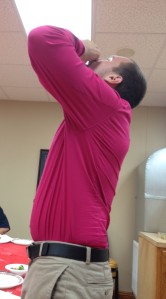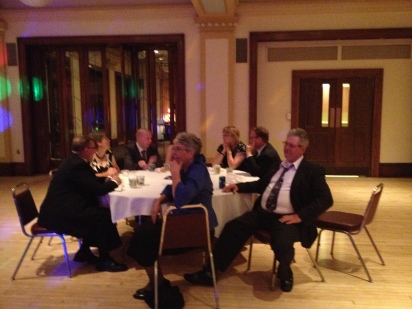Ever have one of those days where everything falls perfectly into place, where nothing deviates from the plan, and everything works out just wonderfully? Saturday was not that day. T and I were set to host Ladies at the Table at the lodge, and numerous things went wrong, including my truck breaking down, the smoker not cooking the brisket not once, but twice, and I think I caught the stove on fire at one point. Luckily, T’s quick thinking resulted in us only being 30 minutes behind schedule, and we were able to have a wonderful dinner and table lodge with our friends and family.
Ladies where?
Ladies at the Table is a very different kind of Masonic event. It is not a degree, a ritual, or ceremony, but it does fall under the jurisdiction of your Grand Lodge, and is usually held at Grand Lodge Communications. The idea is that this is the time for a lodge to show their respect and honor toward a Mason’s lady, widow, mother, daughter, sweetheart, sister…I think you get the picture. Since, more often than not, the Mason will leave his lady home while he eats at the lodge, this is an opportunity for her to come and feel not only welcomed, but supported and honored in her role as a Mason’s lady. It also gives the ladies of the lodge a chance to not only meet the men that her Mason has been hanging out with, but also the other ladies at the lodge, and perhaps spark her interest in joining the Masonic community.
I will get to how the whole business runs, and it really is quite fun, in a moment. First, I want to go over where the idea came from in the first place. During the 18th century, another type of Masonry was being practiced in France, called French Rite, which was established to parallel Masonry. These “Adoptive Lodges”, were women only, and were called such because a regular Masonic lodge “adopted” them. These lodges had four degrees, Apprentice (or Female Apprentice); Compagnone (or Craftswoman); Maitresse (or Mistress); and Parfaite Maconne (or Perfect Mason.) The fourth degree ended with a Table Lodge, or ceremonial banquet. There is a large possibility that young Englishmen, that were en route to be trained as British military officers attended the final degree, or at least the dinner that followed, and brought it back to regular Masonry .The table lodge is still practiced today in many regular jurisdictions, you may have attended one on Saint John’s Day, or around the winter holidays. Please note- Ladies at the Table is not Adoptive Masonry. It is simply a borrowed ceremony that is used by a regular Lodge of Masons to show respect and honor to the Ladies of their Lodge.

The “U” shape. Not ours, I did not think that far ahead!
How is this different from a regular Lodge or Chapter meeting?
If you’ve never been to a table lodge, or Ladies at the Table before, you will find that it is quite unlike anything else you have experienced within Masonry before. As I said above, it is not a Masonic ritual, in fact, T and I decided to make ours a very casual, relaxed event. This does not mean, however, that it is not without it’s own set of governing rules. While these vary from jurisdiction to jurisdiction, as well as Lodge to Lodge, I will give you a general idea:
- Traditionally there are 5 courses and 7 toasts to the meal. Our Lodge decided to be much more informal, and relaxed, and therefore had 3 courses, and probably 10 toasts. Some will say that this does not make it a true “table lodge”, but I think that a lot of things like this you need to adapt to fit your own needs and desires.
- The tables are set in a U shape, with the altar, holding the Bible or other holy book, in the center. T had been in charge of choosing the ritual and letting me know what we needed, and after all of the stress of the day, we realized we had missed this part. Life goes on.
- Wine is the only alcohol served. You may see a lot of rules about how much wine everyone should be poured, or even what alcohol percentage the wine should be. Unless your Grand Lodge has specific rules for this, do what suits your needs.
- The ladies should not be the ones cooking, or serving this meal. The idea is to show how much you appreciate them by doing what they normally might on any other lodge night.

T demonstrating the meaning of the word “Fire.”
How does the whole thing work, though?
The table lodge is opened similarly as regular lodge might, albeit a much abridged version, with only a few speaking parts, all suitable for the public of course. Usually the opening ceremonies include a short history of the table lodge, or of Ladies at the Table itself, as well as a history of the lodge that it is taking place in.The Chaplin gives a prayer to open. All of the work is conducted by the Worshipful Master, of course, who sits in the middle table of the “U” with his lady. After opening the Ladies at the Table, dinner is served. When everyone has had their fill, the real fun begins.
In addition to their water cups, everyone has a large shot glass at their seat. This is a special type of shot glass that is a bit thicker on the bottom, and with good reason. It is referred to as a “cannon”, and looks like this. After dinner is over, but before the toasts begin, someone, either the Worshipful Master or the Steward, instructs those attending how the toasts will be done. It goes something like this:
WM: “Brother Senior Steward, charge and align the Cannons of the column of the North. Brother Junior Steward, charge and align the Cannons of the column of the South.” The Stewards fill everyone’s cannons with wine.
WM: “Brothers Senior and Junior Steward, are you cannons charged?” They answer affirmatively.
The WM recognizes the person giving the toast, all rise, and the toast is given.
WM: “With me…” Everyone repeats the last line of the toast, for instance, “to the United States of America,” raising their cannons normally.
WM: “Ready.” Everyone brings their cannons closer to their body.
WM: “Aim.” Cannon is brought to the lips.
WM: “Fire!” The shot of wine is downed.
WM:”Order.” The cannon is brought to just above the table.
WM: “Arms.” Everyone slams their cannon down on the table, hopefully at the same time, resulting in a terrific noise. (Usually it tends to get better with time, and then worse again.)
Traditionally, there are seven toasts made, as I stated above. At a Ladies at the Table, they are as follows:
- To the first lady of the United States
- To the wife of the Grand Master
- To 3 different women of the Lodge
- To our mothers
- To our ladies
We chose to do things a bit differently, and added many of our own toasts, including:
- To our service men and women
- To the United States of America
- To our Grand Lodge
- To the Craft
- T also added a special poem he had found about the ladies for the final toast. You can see that here.

The cannons being charged.
So, the point is….?
If you are thinking to yourself that there must be something more to this than having a nice dinner, shooting wine, and being with the ladies of the lodge, then you would be pondering what else there is for some time. The whole point is to relax, have a nice time, and be with friends and family.
If any of you are interested in hosting your own Ladies at the Table, let me know! I would love to hear stories of the way that other Lodges decide to put it on. Make it your own, and start your own tradition!

















